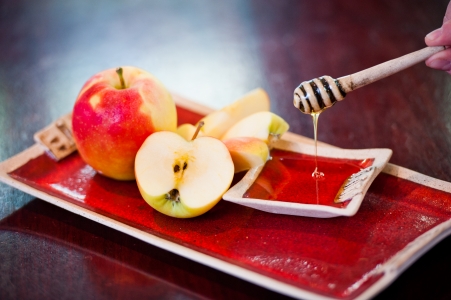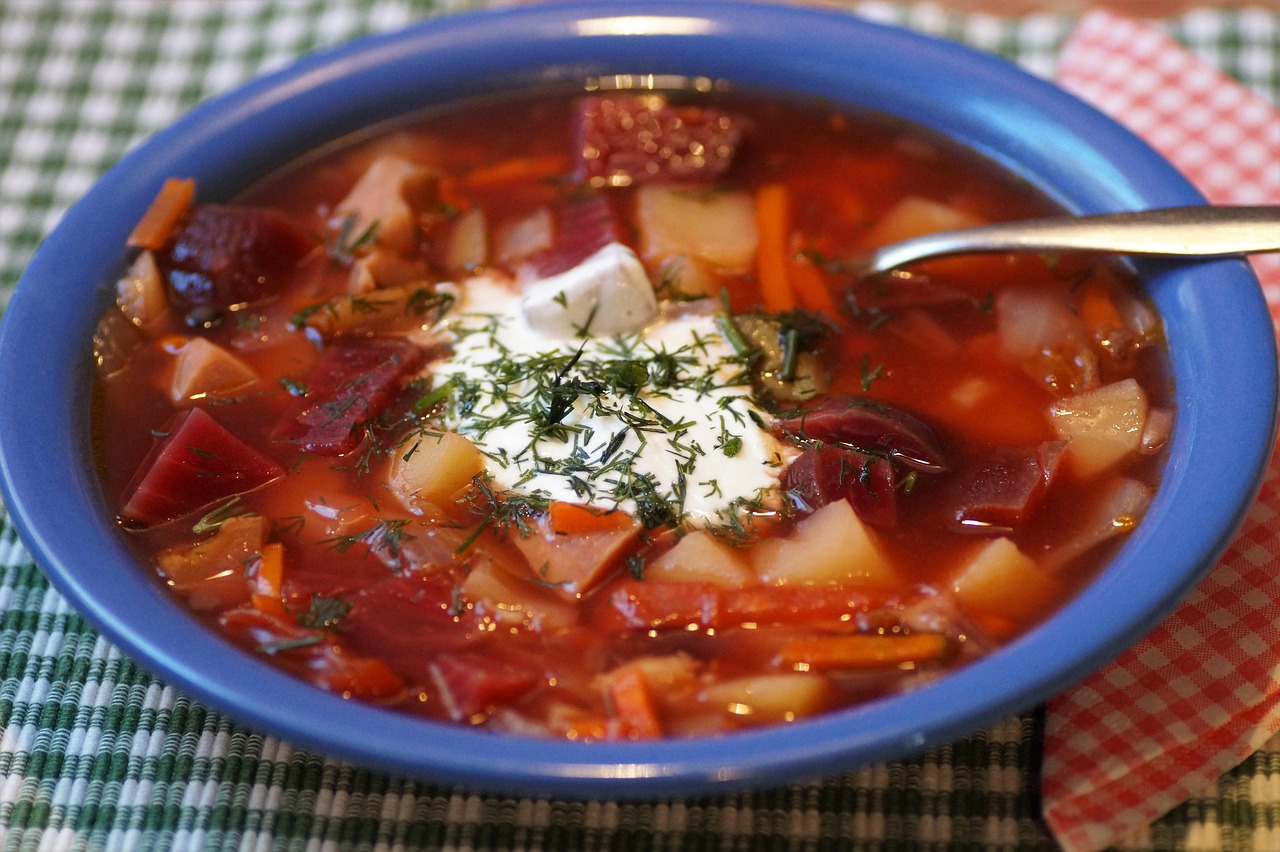DATES
Sweet dates are served to symbolize the wish that the New Year will be equally sweet. After reciting the yehi ratson prayer (below), most Sephardim eat the dates as they are. Some Moroccan Jews add a gourmet touch. They dip the dates in a mixture of ground sesame seeds, anise seeds, and powdered sugar. (Apples are also dipped in this mixture). Interestingly, yitamu, which sounds like tamar, the Hebrew word for date, is introduced in the yehi ratson in a sense that gives this word another meaning. Yitamu hata’im literally means “May the wicked of the earth be removed.”
As we eat this date, may we date the New Year that is beginning as one of happiness and blessing, and peace for all men. Blessed are Thou, Lord our God, Ruler of the universe, who creates the fruit of the tree.
POMEGRANATE
Every pomegranate, it is said, contains exactly 613 seeds, precisely the number of mitzvot, Biblical commandments Jews are obliged to fulfill. As they eat this fruit, Sephardim pray that their lives during the coming year will be filled with as many good deeds as the pomegranate has seeds.
In the coming year, may we be rich and replete with acts inspired by religion and piety as this pomegranate is rich and replete with seeds.
APPLE DIPPED IN HONEY
The apple’s roundness symbolizes a hope that the New Year will be joyous from the beginning until it goes full circle. Dipping an apple in honey expresses a wish for a sweet New Year.
May it be Thy will, Lord our God, God of our father, to grant us a year from the first day to the last, goodly as the apple and sweet as honey. “And Nehemiah said to them, go, eat rich dainties and drink sweet drinks, and send portions to him to has nothing ready, for today is holy to our Lord. Grieve not, for the joy of the Lord is your strength.” –Neh. 8:10
PUMPKIN OR GOURD
Food made with pumpkin is served to express the hope that as this vegetable has been protected by a thick covering, God will protect us and gird us with strength. The Hebrew word for pumpkin or gourd is kara. Sephardim pun on this and say “yikaru lefanekha z’khuyoteinu,” May our good deeds be called out before the Lord at the time of Judgment.
“May the coming year grow as a gourd in fullness of blessing. In the year to come, if enemies gird at us, mayest Thou guard us as we eat of this gourd with the prayer: Blessed art Thou, Lord our God, Ruler of the universe, who creates the fruit of the earth.”
LEEK
Karti is the Hebrew word for leek. In the yehi ratson, Sephardim say “yikartu oyvekha,” May all of God’s enemies be cut off. This pun in English on “leek” probably evokes more chuckles than any other double-entendre in the yehi ratson ceremony.
Like as we eat this leek may our luck never lack in the year to come.
BEETROOT
Sephardim generally perform the yehi ratson with spinach or swiss chard, although the leafy part of the beet may also be used. In English translation, the stress is on our desire to “beat” those who intend to do us harm. Silka is the Hebrew word referring to the greens mentioned above. The verse that begins “yistalku oyvekha” also expresses the wish that the enemies of the Jews will be removed.
As we bite this beet, may those who in the past have beaten us or sought our harm beat to cover in the coming year.
SHEEP OR FISH HEAD
“Rosh Hashanah” literally means head of the year. The sheep or fish head symbolizes the hope that each of us will be at the head of whatever we do, rather than at the tail end.
May it by Thy will, Lord our God, God of our fathers, that in the coming year we may go ahead in all we undertake. “And the Lord will set thee ahead and not back, and thou shalt go only upwards and not down, when thou wilt hearken to the commandments of the Lord thy God which I command thee this day to observe, and to do them.” –Deut. 28:13
ROSH HASHANAH Turkish Menu
-
Pan de Calabaza (pumpkin bread)
-
Keftes de Prasa (leek croquettes)
-
Fritadas de Calabaza (pumpkin croquettes)
-
Lubiya (black-eyed peas)
-
Keftes de Espinaca (spinach croquettes)
-
Arroz (Turkish rice)
-
Pollo con Susam (sesame-seed chicken)
-
Borekas de Calabaza (pumpkin turnovers)
-
Tishpishti (honey-nut cake)
-
Kaveh (Turkish coffee)
PAN DE CALABAZA (Pumpkin Bread)
Makes 2 loaves and 12 rolls
The pumpkin, symbolic of wishes for a well-rounded and full year, adds a golden color and extra moistness to this bread.
Ingredients
-
2 packages active dry yeast
-
1/2 cup sugar
-
2 cups warm water (105-115 degrees F)
-
Half teaspoon ground ginger
-
1-1/2 teaspoons ground cardamom
-
2 teaspoons salt
-
1/2 cup vegetable oil
-
3 eggs, divided, lightly beaten
-
1 cup canned cooked pumpkin
-
8-1/2 cups all-purpose flour
-
2 tablespoons sesame seeds
Preparation
1. In a large bowl, dissolve yeast and sugar in water. Let stand for 10 minutes.
2. Mix in ginger, cardamom, salt, oil, 2 eggs, and pumpkin, Blend in flour, 2 cups at a time, mixing well after each addition.
3. On lightly floured surface, knead dough until smooth and elastic, 8-10 minutes. Reflour surface if dough is too sticky.
4. Place ball of dough in large, greased bowl. Turn dough in bowl so entire surface is greased. Cover bowl with clean dish towel and allow to rise in warm, draft-free place until doubled in bulk, about 1 hour.
5. Punch dough down. On lightly floured surface, form 2 loaves and 12 rolls. Place each loaf in lightly greased 9x5x3 inch pan. Place rolls on lightly greased cookie sheet. Cover and let rise in warm, draft-free place until doubled in bulk, about 45 minutes.
6. Preheat oven to 375-degrees F. Brush tops of loaves and rolls with remaining beaten egg. Sprinkle with sesame seeds. Bake 20 minutes and remove rolls. Bake loaves additional 25 minutes, or until golden brown. Remove from oven and let cool for 20 minutes in pans. Remove from pans and cool completely on racks. Loaves and rolls may be frozen.
KEFTES DE PRASA (Leek Croquettes)
Makes 30
Popularly known as prasafuchies, leek croquettes are favorites in an authentic Turkish Rosh Hashanah meal. Keftes de prasa are attractive when served on a platter garnished with lemon wedges and parsley sprigs.
Ingredients
-
12 large leeks
-
3 matzot or 4 slices bread
-
3 eggs
-
1 teaspoon salt
-
1/4 teaspoon pepper
-
2/3 cup chopped walnuts (optional)
-
Matzo meal
-
Vegetable oil for frying
-
Juice of 2 lemons (about 4 tablespoons)
Preparation
1. Wash leeks well to remove sand. Cut off and discard roots and tough outer leaves. Cut remaining parts crosswise into thin slices and place in large bowl of cold water. Change water several times. Drain well.
2. Place in deep saucepan with water to cover. Cover and boil until tender, 45-50 minutes. Drain and set aside until leeks are cool enough to handle. Take handfuls of cooked leeks and squeeze out as much liquid as possible.
3. Soak matzot in cold water for about 5 minutes. Squeeze out as much water as possible.
4. In large bowl, mix leeks, matzot, eggs, salt, pepper, and nuts. Mixture should be thick enough to form into patties. If mixture is too mushy, add matzo meal, one tablespoon at a time until mixture is easy to handle.
5. Form into patties about 2 inches in diameter and half-inch thick. Dip in matzo meal and fry in hot oil until golden on both sides. Drain on paper towels. Refrigerate until ready to serve, or sprinkle with lemon juice and serve at once.
6. To reheat, place keftes in baking pan and sprinkle with lemon juice. Heat in 250-degree oven for 30 minutes.
Variation: As an alternative to warming keftes with lemon juice, reheat in sauce made by combining half-cup tomato sauce; quarter-cup water, and juice of 1 lemon. Pour sauce over keftes and heat in a 250-degree oven for 30 minutes.
From Sephardic Holiday Cooking by Gilda Angel (Decalogue Books, 1986.) Reprinted with permission of Decalogue Books.













